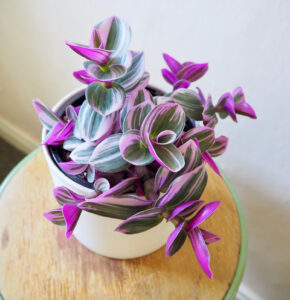The String of Turtles (Peperomia prostrata) is a beautiful and unique trailing succulent, renowned for its small, round leaves that resemble turtle shells. Native to tropical regions of South America, this low-maintenance plant has gained popularity for its striking appearance and relatively easy care requirements. Whether you’re a novice gardener or an experienced plant enthusiast, this care guide will help you ensure your String of Turtles thrives in your home.
1. Light Requirements
String of Turtles prefers bright, indirect light. While it can tolerate lower light conditions, it thrives best when exposed to moderate to bright indirect light. Direct sunlight can scorch the leaves, causing them to become discolored or dried out.
Best lighting locations:
- A north or east-facing window is ideal since it offers bright, indirect light.
- If you need to use artificial lighting, a grow light can provide the necessary light for healthy growth.
Signs of improper lighting:
- Too little light: The plant’s growth may become leggy, and the leaves may lose their variegation.
- Too much direct sunlight: The leaves may scorch or dry out, especially if they are exposed to sunlight for extended periods.
2. Watering
Like most succulents, the String of Turtles is drought-tolerant but requires careful attention to watering. Overwatering is one of the most common mistakes with this plant. It’s important to allow the soil to dry out completely between waterings.
Watering tips:
- Water your String of Turtles when the top 1-2 inches of soil feel dry to the touch.
- During the growing season (spring and summer), watering every 1-2 weeks is typical, but it depends on the humidity and temperature of your home.
- In winter, when the plant is dormant, reduce watering to every 3-4 weeks.
- Always ensure that the pot has drainage holes to allow excess water to escape, preventing root rot.
Signs of improper watering:
- Overwatering: Yellowing or mushy leaves, especially near the base of the plant, indicate overwatering.
- Underwatering: The leaves will begin to shrivel and appear dry if the plant is not receiving enough water.
3. Soil
String of Turtles requires well-draining soil to thrive. A regular potting mix can hold too much moisture, which can lead to root rot. Instead, use a cactus or succulent-specific mix that allows for quick drainage. Alternatively, you can make your own mix by combining:
- 1 part regular potting soil
- 1 part perlite or pumice (to enhance drainage)
- 1 part sand (to further improve drainage)
This mix will ensure that excess water drains quickly, allowing the roots to stay dry between waterings.
4. Potting and Containers
Choose a container with drainage holes to ensure proper water drainage. This is essential to prevent water from pooling at the bottom of the pot, which can lead to root rot.
Choosing the right pot:
- Size: Select a pot that is just slightly larger than the root ball of the plant. Avoid using a pot that is too large, as it may cause the soil to retain excess moisture, increasing the risk of overwatering.
- Material: Terracotta or clay pots are ideal because they allow moisture to evaporate faster than plastic pots. However, plastic pots with drainage holes will also work fine.
5. Temperature and Humidity
String of Turtles thrives in warm, humid conditions, making it well-suited for indoor environments. The ideal temperature range is between 65°F and 75°F (18°C – 24°C). This plant is not frost-tolerant and should be kept in temperatures above 50°F (10°C).
In terms of humidity, String of Turtles enjoys moderate to high humidity, although it can tolerate average indoor humidity levels. If you live in a particularly dry climate or have a dry indoor environment, consider increasing humidity by placing the plant on a humidity tray or using a humidifier.
Signs of temperature or humidity stress:
- Low humidity: Brown or crispy leaf edges can indicate low humidity.
- High temperature: If exposed to too much heat, the plant may show signs of dehydration, with the leaves becoming dry or shriveled.
6. Fertilizing
String of Turtles is not a heavy feeder, but providing the right nutrients can help promote healthy growth. During the growing season (spring and summer), you can fertilize the plant once a month with a balanced, diluted liquid fertilizer for houseplants or succulents.
How to fertilize:
- Use a water-soluble fertilizer and dilute it to about one-quarter strength to avoid overfeeding.
- Fertilize only during the growing season and avoid fertilizing in the winter when the plant is dormant.
- Over-fertilizing can lead to weak, leggy growth or a build-up of salts in the soil.
7. Repotting
String of Turtles is a relatively slow-growing plant, so it won’t need to be repotted very often. Typically, you should consider repotting when the plant has outgrown its pot or if you notice the roots emerging from the drainage holes.
When repotting:
- Choose a slightly larger pot with good drainage.
- Be sure to use fresh, well-draining soil to help the plant settle into its new home.
8. Pruning and Propagation
String of Turtles is a trailing plant that may require occasional pruning to keep its growth neat and compact. The vines can grow several feet long, and trimming them back can encourage new growth.
How to prune and propagate:
- Use clean, sharp scissors or pruning shears to trim the stems as needed. Cutting just above a leaf node will promote new growth.
- String of Turtles is relatively easy to propagate through stem cuttings. To propagate, cut a healthy stem and place the cutting in a small container with well-draining soil. Alternatively, you can propagate in water until the roots form and then transplant into soil.
- Let the cuttings dry for 24 hours to allow the cut ends to callous before planting them to avoid rot.
9. Common Problems and Solutions
While String of Turtles is relatively low-maintenance, a few problems can arise if the plant is not cared for properly. Here are some common issues:
- Yellowing or mushy leaves: This is often a sign of overwatering. Let the soil dry out completely before watering again, and ensure the pot has good drainage.
- Leggy growth: If the plant is not getting enough light, its growth may become leggy. Move it to a brighter location or provide supplemental light.
- Crispy or dry leaf edges: This may be due to low humidity or underwatering. Increase humidity around the plant and ensure consistent watering.
10. Toxicity
String of Turtles is non-toxic to humans and pets, making it a safe plant to have in homes with children or animals.
Conclusion
String of Turtles is a charming and relatively easy-to-care-for trailing succulent that makes a beautiful addition to any plant collection. By providing it with the right amount of light, water, and humidity, you can ensure that it continues to thrive and produce its unique, turtle shell-like leaves. With occasional pruning and attention to watering habits, your String of Turtles will become a delightful and low-maintenance plant companion.


